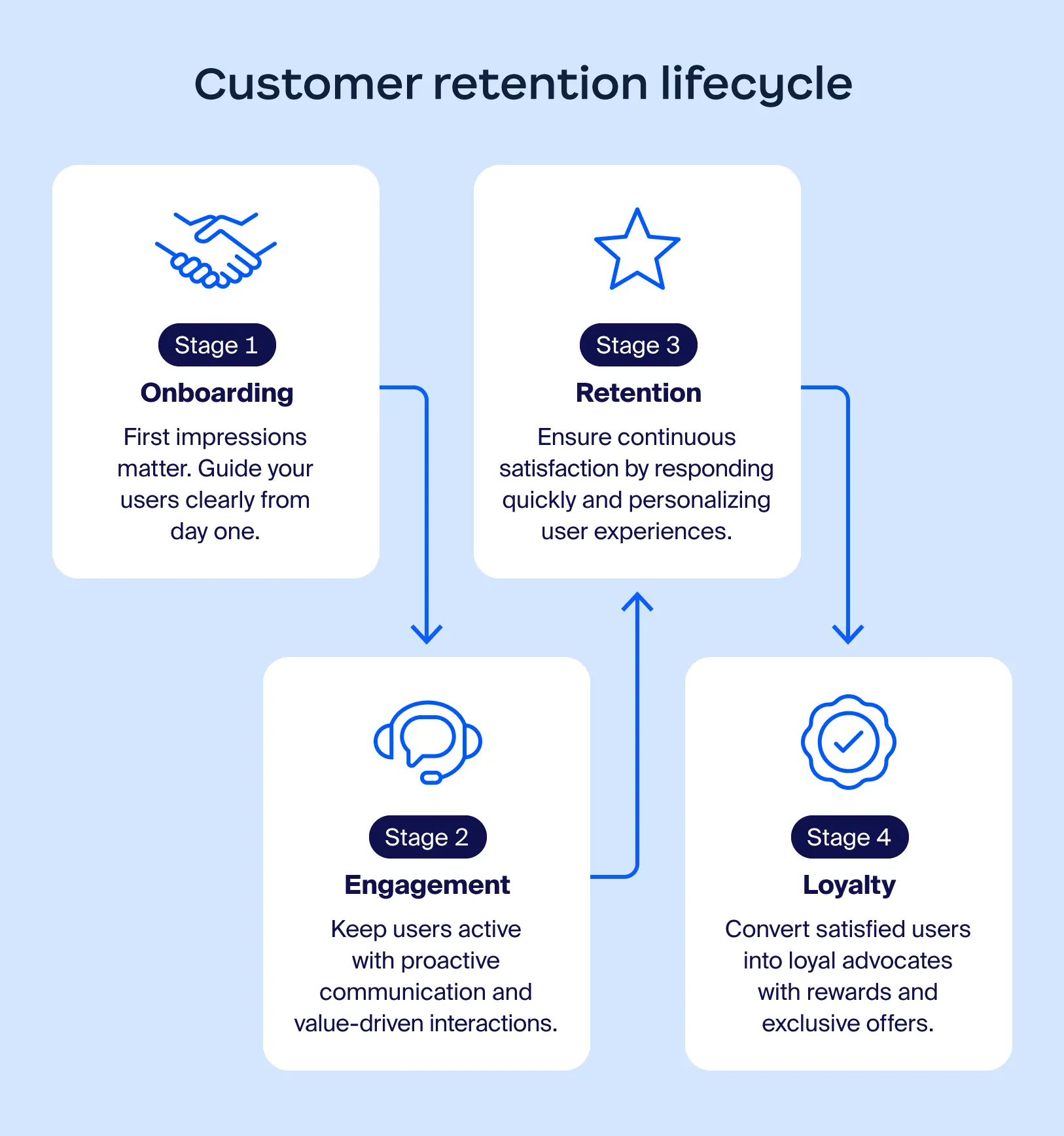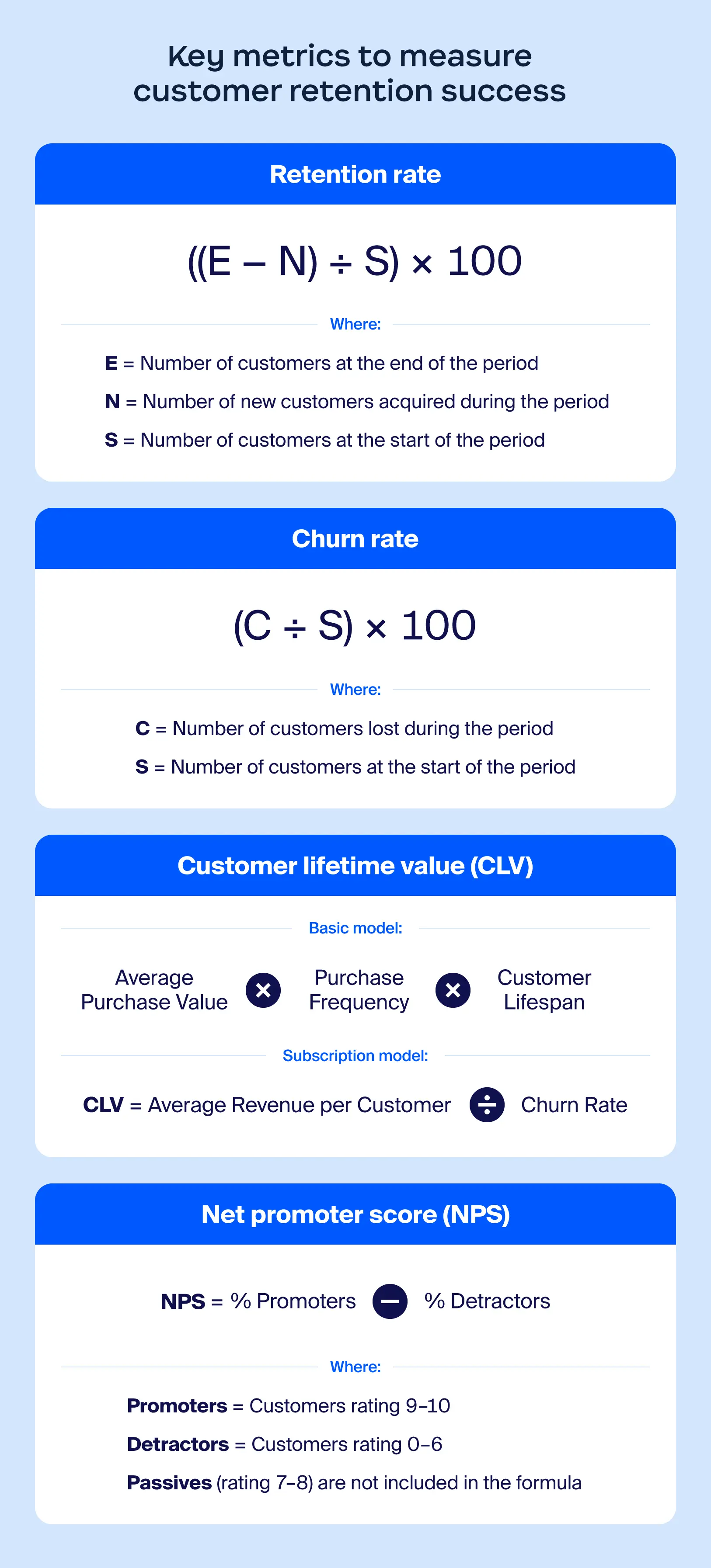
Meet Zoom AI Companion, your new AI assistant!
Boost productivity and team collaboration with Zoom AI Companion, available at no additional cost with eligible paid Zoom plans.
Updated on August 20, 2025
Published on August 20, 2025


It's anywhere from five to 25 times costlier to find new customers than to keep existing ones, according to a 2014 study by Bain & Company. Since it's much more cost-effective to retain customers, providing good customer service and developing effective customer retention strategies is critical.
When effective, these strategies enable your business to grow, as you aren’t constantly chasing new clients. Your business’s long-term profitability and revenue are directly impacted by both the number of repeat customers you have and the number of referrals you get from satisfied customers.
Since you’ll enjoy greater profitability from focusing on customer retention rather than customer acquisition, it’s worth investing in ways to keep customers happy. This guide will walk you through how to do just that through effective customer retention strategies.
Customer retention refers to your ability to keep customers satisfied and engaged so they continue doing business with you. In a nutshell, customer retention is how you can create a loyal customer base.
If you keep existing customers happy, they will turn to you repeatedly for products and services. This repeat business helps you grow more profitable since you’ll have steady repeat business and won’t need to constantly advertise or seek out new clients.
Companies with many repeat customers benefit from referrals and word of mouth. They can achieve far greater success than those with high customer turnover or churn.
Customer retention efforts must persist at all phases of the customer journey. The table below showcases the key components of the lifecycle.

Today, customers have more choices than ever, with the ability to buy products and services from across the globe with a single click. With 26% of consumers saying they would leave a brand after just one poor interaction, delivering top-notch support and affordable products or services is now more important than ever (Morning Consult, 2024).
If you want to keep customers coming back and benefit from stable recurring revenue, you’ll want to think about incorporating certain techniques, such as:
When a business can sign up subscribers or otherwise take steps to get repeat customers, this increases the lifetime value of each client and reduces the cost of customer acquisition (CAC). It also allows the business to have predictable revenue streams, which results in better cash flow management.
It’s a good idea for companies to calculate their customer retention rate to determine if they’re effective at driving repeat business or have a high churn rate and need to make improvements.
The formula below shows how to calculate this critical number.
| Retention rate = ((Customers at the end of Period - New customers) / customers at the start of period) x 100 |
Say, for example, your product offering is an app that has 8,000 paying subscribers at the start of the first quarter. You sign up 850 new customers during that quarter, but you lose 400 customers who unsubscribe.
At the end of the quarter, you would have 8,450 customers (8,000 to start with minus 400 lost customers plus 850 new customers). This is how you’d work out your customer retention rate:
Your customer retention rate would be 95%.
Keep in mind that there's a great deal of variability in customer retention rates by industry. For example, the retention rate in the retail industry is low (around 63%). On the other hand, it's fairly high for insurance (83%) and media companies (84%).
Businesses can measure their retention rate either monthly, quarterly, or annually. If you operate in a fast-moving industry, such as SaaS, you might want to measure it frequently. Measuring monthly, at a minimum, is a good rule of thumb, and perhaps even more often. This will account for any user base fluctuations.
In addition to tracking retention rate, it’s worthwhile to measure:
The table below shows you how to easily calculate these key metrics. Tracking them will help determine if customers are staying with your business over time and generating ROI. It will also help you understand if you are losing too many customers or getting little value from those you do acquire.

It’s helpful to know the customer retention definition, but it’s even more important to learn how to retain customers.
With the right customer retention strategies, you can improve customer loyalty and positively impact your entire organization. The 14 techniques below will help you hold on to your customers and improve business operations.
Onboarding is often the first impression customers have of your company and it can have a long-lasting impact. With this in mind, it makes sense that creating a great onboarding process is one of the most effective strategies.
The goal is to make it as easy as possible for customers to use your product or service as soon as they sign up or buy. This helps build customer trust and loyalty from day one and creates a favorable impression of your business in their minds.
Some of the best ways to provide a positive onboarding experience include:

Another key factor is making sure people know how to use your product with minimal confusion from the start.
Steep learning curves are common customer service complaints. Offering tutorials, product tours, and welcome emails can help you proactively anticipate pain points and resolve little issues before they become big ones.
Offering live chat and email support is also helpful, making it easy and fast for new customers who need extra help to get the assistance they need. Video tutorials and a comprehensive knowledge base are also invaluable in guiding customers on how to make the most of your products.
Customers want to feel like your company cares about them and is invested in a continued relationship. That’s why it’s important to schedule regular targeted check-ins and to follow up with new customers.
Here are a few examples of when and how to follow up:
If engagement drops: If you notice they’re not using a core feature, reach out with support.
| “We noticed you haven’t explored our team collaboration tools yet. Here’s a quick guide to help you get started.” |
On a recurring basis: Set periodic check-ins (monthly or quarterly) to maintain the relationship.
| “Just checking in. How’s everything going with your virtual meetings? Happy to help if you’ve run into any snags.” |
Post-support interactions: A quick follow-up after a support case shows you care.
| “Glad we could help resolve the screen sharing issue! We hope everything is still working well. Let us know if anything else comes up!” |
When you have something valuable to share: If there’s a relevant product update or industry trend, pass it along.
| “Our AI meeting summary features just got an upgrade. Here's a breakdown of all the shiny new updates that might be helpful for your team.” |
These small, thoughtful touches help deepen relationships, keep your product top of mind, and increase long-term loyalty.
Many customers who use your product will want to learn about new developments and services.
Your business becomes a trusted resource by offering them this information and helping them stay up-to-date on industry insights. This continued engagement often improves your NPS, which you can measure by asking customers how likely they are to refer you to others.
If customers are confident that your business is an industry expert and on the cutting edge of developing solutions to meet their needs, they are much more likely to remain loyal.
Providing customers with extra incentives to continue doing business with you can be a powerful customer retention strategy.
Customers like to have their loyalty rewarded. They will often continue purchasing products or services from your business if doing so helps them get extra perks. Some common examples of customer loyalty and rewards programs that can improve employee retention include:
Effective customer retention techniques help you keep as many customers coming back as possible. However, many businesses have certain key customers that they especially need to keep in the fold because those customers give them a substantial amount of business.
If your company has especially valuable customer relationships, consider assigning dedicated account managers to those customers. With a single point of contact to turn to with questions or to resolve issues, they are less likely to look elsewhere if something goes wrong.
Predictive analytics helps you anticipate when a customer will leave your business.
Start by gathering data from customer reviews, phone calls to customer service, other interactions with your company, purchase history, and website activity.
Identify key predictive indicators of dissatisfaction to look for in this data, such as frequent customer service calls, complaints on social media, or negative reviews. Then, use this data to identify at-risk customers or disengaged users and bring them back through special incentives or updates.
By continually setting goals to improve revenues and profits, customer retention, and operational efficiency, you can help your business grow.
That’s why it’s so important to invest in your customers. Providing product training and tools that help customers build skills will encourage them to stay loyal. They’ll feel more comfortable with your product and less likely to switch to a competitor.
Listening to your customers and proactively addressing their concerns can significantly boost conversion rates, increase retention, and improve your customer experience.
A customer experience maturity model helps you effectively track how well you meet customer expectations. Call center metrics also reveal how effectively your team addresses needs.
Using this data, determine what changes and improvements to make. Keeping customers updated about your product roadmap can also build loyalty and earn trust by demonstrating that you are focused on meeting their needs.
Empowering customers is another client retention strategy, as customers who can help themselves are less likely to become frustrated. Here’s how:
Offering these and other self-service tools can make your customers feel more confident and well-equipped when using your products.
Customers like to feel like they’re part of a community, and they’re much more likely to be loyal to your business if that’s the case. Helping customers connect with each other and feel like part of something larger encourages them to stay with your company for the long term.
Building community may involve creating Facebook groups and dedicated chat channels. Organizing user meetups and virtual events can also be effective techniques.
Customers who take part in the community can interact, share insights, and learn from peers, so everyone involved gets more value from your products and services.
When considering the goal of encouraging retention and repeat purchases, it’s clear that offering proactive recommendations is a great way to keep customers coming back.
Anticipating your customers’ needs allows you to send them information on new products and new features they can try. If customers feel like you’re solving their problems, they’ll have no reason to look elsewhere.
Providing personalized feature walkthroughs, sending targeted tips via email, and tailoring user experiences based on customer usage patterns can all be great ways to show customers you’re invested in them.
Making it easy for customers to pay their bills and renew their accounts is another great customer retention strategy.
No one wants to spend a ton of time figuring out how to buy your products or services. The easier you make it for them to find this information, the more likely they’ll keep doing business with you.
Techniques like monthly or annual billing options, tiered subscription plans, customized renewal packages, and transparent pricing policies help customers understand their costs and pay for your services with ease.
Sometimes, customers choose to leave despite your best efforts at retention. When this happens, you’ll want to offboard them thoughtfully to maintain the relationship and give them a reason to come back.
There are many ways to make offboarding effective and pleasant for all, including:
Here are a few examples of customer retention strategies companies have implemented in real life. These customer retention examples provide insight into what other businesses have done to keep customers coming back for the long term.
Reading about what these real-life businesses have done can help you improve strategies in your own business.
Chewy is well known for its high customer service, including its offboarding strategy when customers cancel dog food or medication deliveries after the death of a pet.
In 2022, Today covered an example of Chewy’s excellent customer service. A customer contacted the company to return dog food after her dog’s death. Chewy told her to keep the food and donate it to a shelter. The company also provided a full refund and sent her flowers.
There have been many other cases where people have shared similar experiences with Chewy. This kind of offboarding will keep Chewy top of mind for customers when they get a new dog. Plus, the positive word-of-mouth advertising Chewy received was invaluable.
Spotify offers lengthy trials to convince customers to try their premium product. Once customers get used to the upgraded experience, they often don’t want to downgrade back to the free version.
Spotify also points out its features for new users, has an effective onboarding program showcasing the exclusive benefits that come with premium, and uses AI to generate personalized experiences that effectively meet listeners’ needs.
Features like Spotify Wrapped also help build community, generating excitement as users share personalized reports of the music they listened to throughout the year.
Starbucks offers a Rewards Program with millions of active members, and the company attributes as much as 40% of its total sales to this program (according to 2019 data).
Rewards members get perks like free refills on brewed coffee and free drinks on their birthday.
The Starbucks mobile app makes payment effortless, allows customers to order ahead, makes it easy to send other members gift cards, and integrates with other well-loved apps like Spotify to enhance the coffee house culture.
The above examples show effective customer retention techniques, but there are also some ways you could jeopardize your ability to keep customers. Here are some key mistakes you should avoid making:
By avoiding these mistakes, you can improve customer retention and have a better chance of effectively growing your business.
Now you know more than just the definition for customer retention — you know how to improve customer retention.
And there are tools out there that can help. Zoom CX is an AI-first customer experience solution that can enable you to meet your customers at every stage of the customer lifecycle. It can help you connect your teams, solve issues fast, and transform your service from meh to memorable.
With Zoom CX, you can build customer loyalty from day one by proactively tracking customer interactions to monitor satisfaction while providing an omnichannel experience. Customers can get answers they need when they need them, and because agents’ tasks are automated, they get more time to focus on higher-value service interactions with customers.
Harnessing the power of Zoom CX can enable you to empower teams and improve retention, turning agents into heroes and customers into fans. Empower agents and enhance the business experience.
Reach out today to speak with one of our experts. They’d be happy to talk through what Zoom CX can do for your business.